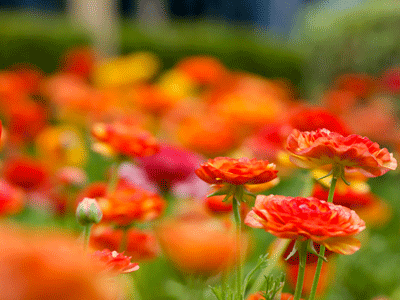If you’re looking to brighten up your yard and have eye-popping flowers available to display in a vase, plant ranunculus. Ranunculus come in a rainbow of colors for the home gardener and would-be florist. The flowers will bloom most of the summer and can be used to create a simple floral display. The plant will continue to bloom after the flowers have been clipped off; in fact, cutting them back encourages more blooms.
If you’re looking for bolder colors for your garden, ranunculus are one of the more vibrant flowers. Ranunculus have large, full flowers with thin, delicate petals. Colors include yellow, orange, salmon, pink, and white. Height ranges from 12″ to 18″ with a spread of about 12″. Ranunculus asiaticus is the most popular of the 600 or so species of ranunculus. The common name is Persian buttercup.
When to plant:
Plant ranunculus in the fall after the weather has cooled in zone 8 and above. Ranunculus can take a light frost but not prolonged freezing temps. In zones 4-7, treat as an annual and plant in early spring.
Where to plant:
For best results, plant ranunculus in moist, fairly rich, well-drained soil in full sun.
Planting depth:
Bury the bulb under three inches of soil.
Spacing:
Space ranunculus bulbs 6″ apart.
Planting ranunculus bulbs with the ProPlugger 5-IN-1 Planting Tool:
Let’s face it, most bulb planting methods have us spending a lot of time bending over or on our knees. The ProPlugger 5-IN-1 Planting Tool allows you to do most of the hard work of digging your bulb planting holes from a standing position.
To pull plugs, slide the 2″ or 4″ metal depth ring onto the bottom of the main tube to set the desired depth of the planting hole. Or to dig a 6″ deep hole, no depth ring is needed.
(Step, Twist and Pour) Step down on the foot pegs until the depth ring bottoms out against the ground. Give the 5-IN-1 a slight twist to break the soil plug free and pull straight up on the handlebars. To empty the plugs, simply turn the plugger upside down and pour the plugs out of the top of the tube.
The soil gets stored inside the tool as you work, enabling you to dig over a dozen planting holes, one right after another. Place the bulb in the planting hole, pointed tip facing upward. Fill in the hole with the soil you removed with the 5-IN-1. Firm the soil over the bulb with your foot.
Feeding:
To encourage continued blooming, apply an all-purpose fertilizer right after planting at the recommended rate for flowers and later with a light feeding about every two weeks. Mulching around the plants with aged compost or well-rotted manure will help conserve moisture and nutrients.
Disease and pest problems:
Unfortunately ranunculus has a reputation for being prone to disease and insect problems. Topping the list are two fungal diseases: rust and powdery mildew. Prevention is the key when dealing with fungal problems. Begin the season by applying a fungicide, such as Captan, or the copper based Soap Shield from Gardens Alive before a fungal disease has a chance to develop. Proper spacing and good air circulation are preventative measures. Aphids can also be a problem and can be controlled with regular applications of a pyrethrum-based insecticide. Since birds and beneficial insects will feed on aphids, it’s important to apply an insecticide that won’t harm wildlife.
Neil Moran is a horticulturist and author of three books on gardening. He is also the creator and author of the garden blog North Country Gardening.
Be sure to check out the helpful information on our website, including other uses for the ProPlugger including:

